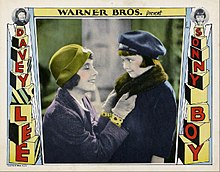
The Gay Divorcee is a 1934 American musical film directed by Mark Sandrich and starring Fred Astaire and Ginger Rogers. It also features Alice Brady, Edward Everett Horton, Eric Blore, and Erik Rhodes. The screenplay was written by George Marion Jr., Dorothy Yost, and Edward Kaufman. It was based on the Broadway musical Gay Divorce, written by Dwight Taylor with Kenneth S. Webb and Samuel Hoffenstein adapting an unproduced play by J. Hartley Manners.
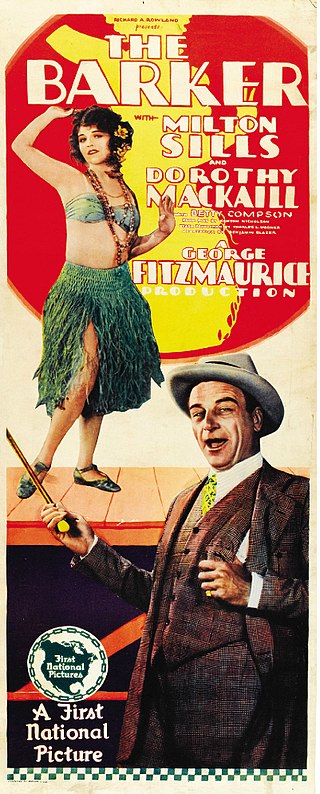
The Barker is a 1928 part-talkie pre-Code romantic drama film produced and released by First National Pictures, a subsidiary of Warner Bros., acquired in September 1928. The film was directed by George Fitzmaurice and stars Milton Sills, Dorothy Mackaill, Betty Compson, and Douglas Fairbanks Jr.

The Singing Fool is a 1928 American sound part-talkie musical drama motion picture directed by Lloyd Bacon which was released by Warner Bros. In addition to sequences with audible dialogue or talking sequences, the film features a synchronized musical score and sound effects along with English intertitles. The soundtrack was recorded using the Vitaphone sound-on-disc system. The film stars Al Jolson and is a follow-up to his previous film, The Jazz Singer. It is credited with helping to cement the popularity of American films of both sound and the musical genre.
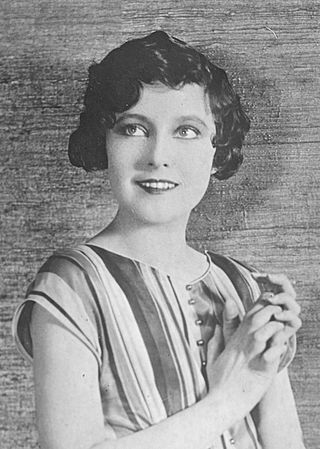
Elizabeth Ada Bronson was an American film and television actress who began her career during the silent film era.

Glorious Betsy is a 1928 sound part-talkie drama film. In addition to sequences with audible dialogue or talking sequences, the film features a synchronized musical score and sound effects along with English intertitles. The soundtrack was recorded using the Vitaphone sound-on-disc system. The film is based on the 1908 play of the same name by Rida Johnson Young, and it stars Dolores Costello. It was produced by Warner Bros. and nominated for an Academy Award for Best Writing, Adaptation in 1929. The film was directed by Alan Crosland with cinematography by Hal Mohr.
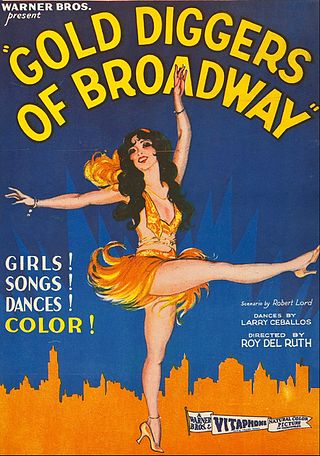
Gold Diggers of Broadway is a 1929 American pre-Code musical comedy film directed by Roy Del Ruth and starring Winnie Lightner and Nick Lucas. Distributed by Warner Bros., the film is the second all-talking, all-Technicolor feature-length film.

Say It with Songs is a 1929 American pre-Code musical drama film, directed by Lloyd Bacon and released by Warner Bros. The film stars Al Jolson and Davey Lee and was a follow-up to their previous film, The Singing Fool (1928).

Davey Lee was an American child actor. He was born in Hollywood, California, United States. He appeared in six feature films between 1928 and 1930.

The Locked Door is a 1929 American pre-Code drama film directed by George Fitzmaurice, and starring Rod LaRocque, Barbara Stanwyck, William "Stage" Boyd and Betty Bronson. It is based on the 1919 play The Sign on the Door by Channing Pollock. The play was first adapted for the screen in 1921 as The Sign on the Door, starring Norma Talmadge. It was Stanwyck's first starring role and first talking film.

My Man is a 1928 black and white sound part-talkie American comedy-drama musical film directed by Archie Mayo starring Fanny Brice and featuring Guinn "Big Boy" Williams. In addition to sequences with audible dialogue or talking sequences, the film features a synchronized musical score and sound effects along with English intertitles. The soundtrack was recorded using the Vitaphone sound-on-disc system.
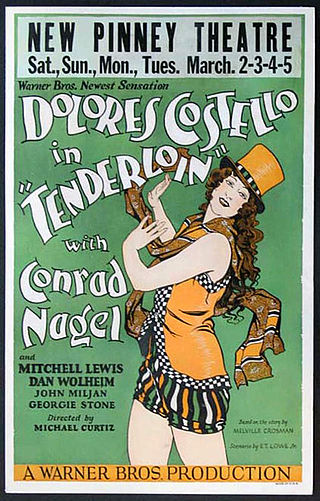
Tenderloin is a 1928 American sound part-talkie crime film directed by Michael Curtiz and starring Dolores Costello. In addition to sequences with audible dialogue or talking sequences, the film features a synchronized musical score and sound effects along with English intertitles. The soundtrack was recorded using the Vitaphone sound-on-disc system. It was produced and released by Warner Bros. Tenderloin is considered a lost film, with no prints currently known to exist.

The Aviator is a 1929 American Pre-Code Vitaphone comedy film produced and released by Warner Bros. Directed by Roy Del Ruth, the film was based on the play of the same name by James Montgomery and stars Edward Everett Horton and Patsy Ruth Miller. The Aviator is similar to the silent comedy The Hottentot (1922), where a hapless individual has to pretend to be a famous steeplehorse jockey. The Aviator today is considered a lost film.

The Terror is a 1928 American pre-Code horror film written by Harvey Gates and directed by Roy Del Ruth, based on the 1927 play of the same name by Edgar Wallace. It was the second "all-talking" motion picture released by Warner Bros., following Lights of New York. It was also the first all-talking horror film, made using the Vitaphone sound-on-disc system.

Wide Open is a 1930 American pre-Code romantic comedy film directed by Archie Mayo, starring Edward Everett Horton and Patsy Ruth Miller, and featuring Louise Fazenda, T. Roy Barnes and Edna Murphy. Released by Warner Bros., it is based on the 1924 novel The Narrow Street by Edward Bateman Morris.

The Hottentot is a lost 1929 American all-talking sound pre-Code comedy film directed by Roy Del Ruth and starring Edward Everett Horton and Patsy Ruth Miller. It is based on the 1920 Broadway play The Hottentot by William Collier, Sr. and Victor Mapes.
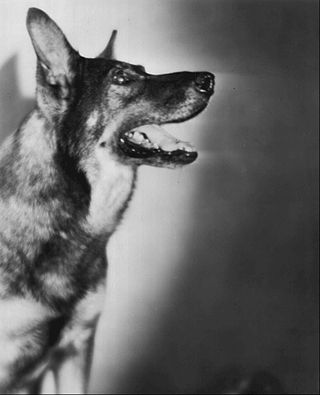
Frozen River is a lost 1929 sound part-talkie film directed by F. Harmon Weight and starring the canine star Rin Tin Tin and boy actor Davey Lee. In addition to sequences with audible dialogue or talking sequences, the film features a synchronized musical score and sound effects along with English intertitles. The soundtrack was recorded using the Vitaphone sound-on-disc system. Warner Bros. produced and distributed the film.

Show Girl is a 1928 American comedy-drama film starring Alice White and Donald Reed. It was based on the first of J. P. McEvoy's two Dixie Dugan novels, as was the 1929 musical. It was followed by a sequel, Show Girl in Hollywood (1930). While the film has no audible dialogue, it is accompanied by a Vitaphone sound-on-disc soundtrack with a musical score and sound effects.
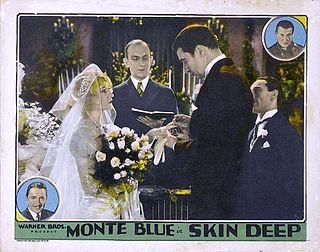
Skin Deep is a 1929 American pre-Code drama film directed by Ray Enright and starring Monte Blue. It was produced and distributed by the Warner Brothers. It was also released in the U.S. in a silent version for theaters not equipped yet with sound. The film is a remake of a 1922 Associated First National silent film of the same name directed by Lambert Hillyer and starring Milton Sills.
Brass Knuckles is a surviving 1927 silent crime film directed by Lloyd Bacon and starring Monte Blue, Betty Bronson and William Russell. It was produced and distributed by Warner Brothers Pictures.

The Sap is a 1929 American sound part-talkie comedy film directed by Archie Mayo and written by De Leon Anthony and Robert Lord. In addition to sequences with audible dialogue or talking sequences, the film features a synchronized musical score and sound effects along with English intertitles. The soundtrack was recorded using the Vitaphone sound-on-disc system. The film is based on the 1924 play The Sap by William A. Grew. The film stars Edward Everett Horton, Alan Hale Sr., Patsy Ruth Miller, Russell Simpson, Jerry Mandy and Edna Murphy. The film was released by Warner Bros. on November 9, 1929. This film was the last "part-talkie" produced by the studio.
